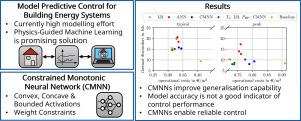Monotonic physics-constrained neural networks for model predictive control of building energy systems
IF 7.6
1区 工程技术
Q1 CONSTRUCTION & BUILDING TECHNOLOGY
引用次数: 0
Abstract
This paper presents a comprehensive evaluation of monotonic physics constrained neural networks for model predictive control of building energy systems. Incorporating physical domain knowledge in machine learning, so-called physics-guided machine learning, aims to increase the robustness of black box models. Following an extensive literature review on physics-guided machine learning and its applications, the Constrained Monotonic Neural Network (CMNN) architecture is selected and implemented, which enforces physical consistency through monotonicity constraints. The model is evaluated on the standardised Hydronic Heat Pump test case provided by BOPTEST and compared to classical artificial neural networks and a physics-informed linear regression. The results demonstrate that incorporating monotonicity constraints improves training stability and extrapolation capabilities. This prevents catastrophic control failures that can be observed with unconstrained networks. The study demonstrates that model accuracy alone is not always a reliable indicator of control performance, emphasising the importance of application-oriented evaluation. While the standard CMNN performs similarly to a physics-informed linear regression with engineered non-linear features, the architecture’s flexibility offers a distinct advantage. Specifically, the CMNN architecture enables additional convex and concave model constraints, which can significantly outperform other models. Furthermore, the impact of online learning, training data coverageand different monotonicity constraints is investigated. Through this comprehensive evaluation, this study aims to advance the understanding and practical implementation of physics-constrained neural networks. Several further research directions are proposed, including complex use case exploration, extensive model comparison and alternative performance measures.

建筑能源系统模型预测控制的单调物理约束神经网络
本文综合评价了单调物理约束神经网络在建筑能源系统模型预测控制中的应用。将物理领域知识整合到机器学习中,即所谓的物理引导机器学习,旨在提高黑箱模型的鲁棒性。在对物理引导的机器学习及其应用进行了广泛的文献回顾之后,选择并实现了约束单调神经网络(CMNN)架构,该架构通过单调性约束来强制物理一致性。该模型在BOPTEST提供的标准化水力热泵测试案例上进行了评估,并与经典的人工神经网络和物理信息线性回归进行了比较。结果表明,加入单调性约束可以提高训练稳定性和外推能力。这可以防止在无约束网络中观察到的灾难性控制故障。研究表明,模型精度本身并不总是控制性能的可靠指标,强调了面向应用的评估的重要性。虽然标准的CMNN执行类似于具有工程非线性特征的物理信息线性回归,但该架构的灵活性提供了明显的优势。具体来说,CMNN架构支持额外的凸和凹模型约束,这可以显着优于其他模型。此外,研究了在线学习、训练数据覆盖和不同单调性约束的影响。通过这一综合评估,本研究旨在促进物理约束神经网络的理解和实际实现。提出了几个进一步的研究方向,包括复杂的用例探索,广泛的模型比较和替代性能度量。
本文章由计算机程序翻译,如有差异,请以英文原文为准。
求助全文
约1分钟内获得全文
求助全文
来源期刊

Building and Environment
工程技术-工程:环境
CiteScore
12.50
自引率
23.00%
发文量
1130
审稿时长
27 days
期刊介绍:
Building and Environment, an international journal, is dedicated to publishing original research papers, comprehensive review articles, editorials, and short communications in the fields of building science, urban physics, and human interaction with the indoor and outdoor built environment. The journal emphasizes innovative technologies and knowledge verified through measurement and analysis. It covers environmental performance across various spatial scales, from cities and communities to buildings and systems, fostering collaborative, multi-disciplinary research with broader significance.
 求助内容:
求助内容: 应助结果提醒方式:
应助结果提醒方式:


